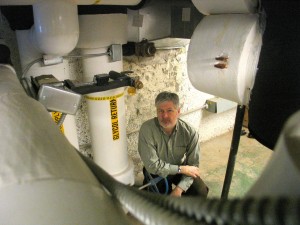
“Geothermal energy” was not on the syllabus when Brad Will earned his architecture degree at Cornell University in 1984.
Fast-forward to 2011 and Will, a board member of the Westchester-Hudson Valley chapter of the American Institute of Architects and principal at Kingston-based Ashokan Architecture, has his architect”™s stamp on 25 commercial geothermal structures and five private homes.
“I was taught about passive and active solar,” Will said. “We were ecologically oriented ”“ we were aware of the compass and how to orient a building ”“ but we did not get into the ”˜deep green.”™ That came later.”
Will”™s current projects include the 53-unit Woodstock Commons intergenerational housing development in Woodstock and multiple dormitory projects at Bard College in Annandale-on-Hudson.
Altruism may have been a selling point for geothermal in the past ”“ the historic payback took seven to eight years, according to Will; too long for most to wait ”“ but today: “For businesses looking to get a handle on energy costs ”“ especially when you factor in cooling ”“ they should look to geothermal.”
Will spoke of the geopolitical world of oil and its associated problems, including the concept of “peak oil,” which states new oil fields from this point forward will not be enough to replace those being depleted. “It”™s much cleaner,” he said of geothermal. “It”™s a way to wean us from dependence on foreign oil until we develop a fail-safe form of design requiring no energy.” That future ”“ so-called “net-zero buildings” ”“ takes the concept of passive energy absorption “to another scale,” he said. “And that is coming.”
Architecture complements a landscape, but it also creates its own interior landscape. “If geothermal and other energy-saving methods are a trend, then interiors with sustainable products are a megatrend,” he said. “It”™s where we”™re all going.” At Ashokan Architecture, San Francisco-trained architect Sari Myers handles interiors.
Regarding geothermal, “Any location is good,” Will said. “There are even a few geothermal buildings in New York City, with the units directly beneath the buildings.”
Depending on the amount of energy required, geothermal wells tap into a steady temperature of about 50 degrees at 300 to 400 feet underground. A glycol-water mix absorbs and sheds the subterranean temperature in a closed loop.
“It”™s a booster; you can think of it as that,” Will said. “At 50 degrees there”™s a built-in jumpstart with the comfort zone only 18 to 24 degrees away.”
Right now, a geothermal system costs about 75 percent more than a traditional fossil fuel-fired boiler system. Larger applications ”“ regional colleges, both public and private, have embraced the concept, including Bard with 13 buildings tapping underground heat ”“ were first with geothermal, but Will said, “In the last few years, single-family units are showing interest.”
The New York Power Authority is currently engaged in a $3.9 million geothermal project to heat and cool upstate Auburn”™s municipal buildings. The ground under Auburn, the Power Authority reported, rests at a temperature between 50 degrees and 70 degrees Fahrenheit. At Westchester Community College, NYSERDA ”“ the state”™s energy research and development agency ”“ cosponsors classes in geothermal and photovoltaic technologies through its Clean Energy Training Partners program.
The difference between geothermal and traditional heating-cooling units begins the day the switch is first thrown. “The savings are cumulative and they start in year one,” Will said. Additionally, there may be tax breaks and depreciation allowances for geothermal.
The idea is catching on, with recent headlines reading: “Scientists propose drilling for geothermal energy in Marathon County” in Wisconsin; “Geothermal: It”™s not just for northern Nevada”; “Kalahari Energy considers geothermal energy in Zambia”; “Forum on geothermal energy to include Hawaiian leaders” and, even as the Japan crisis continues to unfold: “Nuclear disaster ”“ Japan can bridge energy gap using geothermal resources.”
“We are definitely seeing increased interest,” Will said. “With peak oil, there is the potential for a dramatic rise in energy costs.”
















This writer appears to be confusing geothermal energy production with what is usually know as a heat pump. Heat pumps are technically “geothermal energy” but they are fundamentally different from large scale geothermal power plants.
Thehaymarketbomber (quite a handle) is correct. For the record: as the architect and subject interviewee, I was consulted on my experience with geothermal “groundsource” heat pumps, or GSHP, and not on my knowledge of geothermal energy. While I think this alternative source of electricity-producing energy – along with wind, solar, tidal, hydro, and biomass – provides compelling evidence to move away from our reliance on coal, oil, gas, and nuclear, it is clearly a topic that is separate from GSHP and worthy of its own coverage.